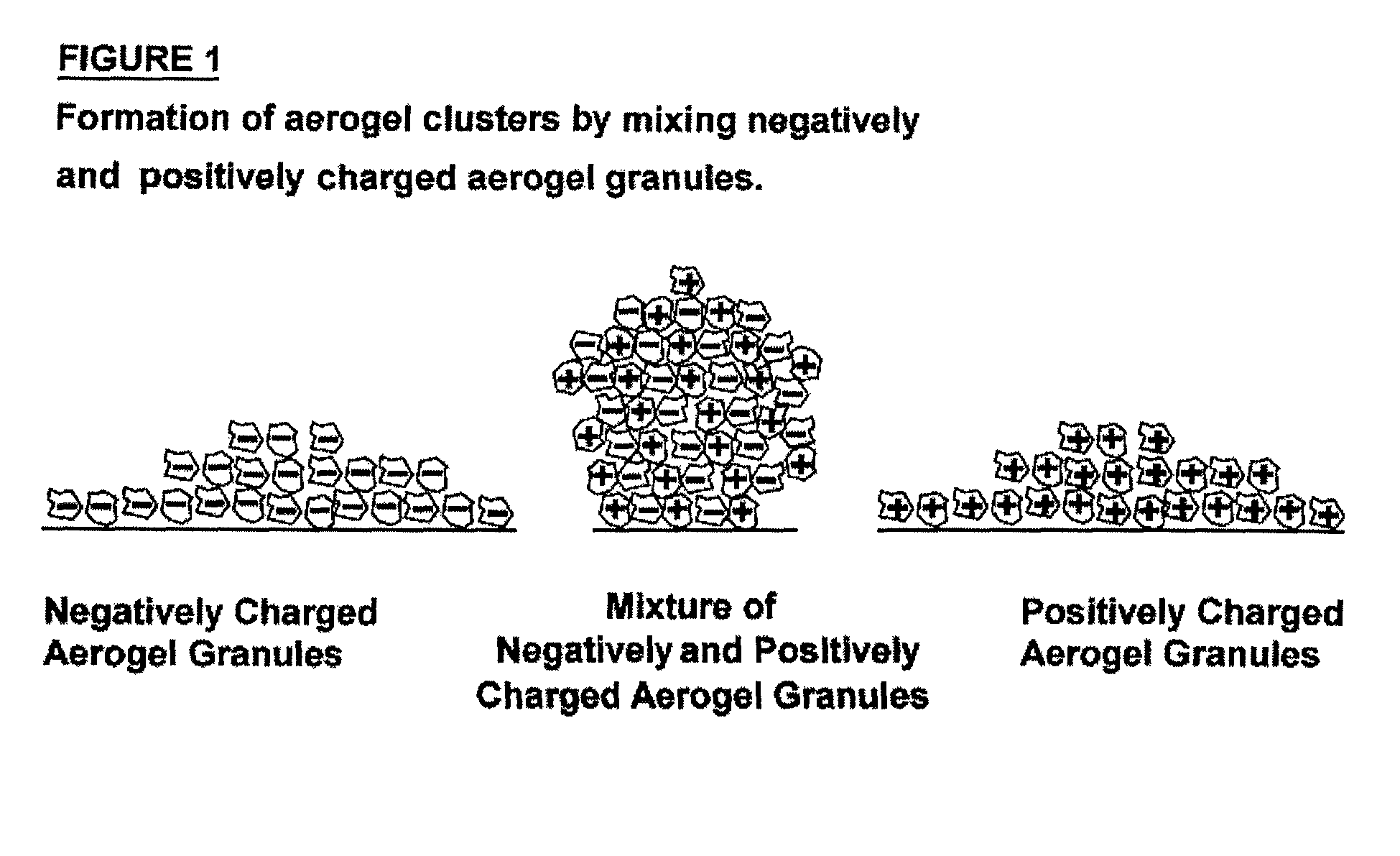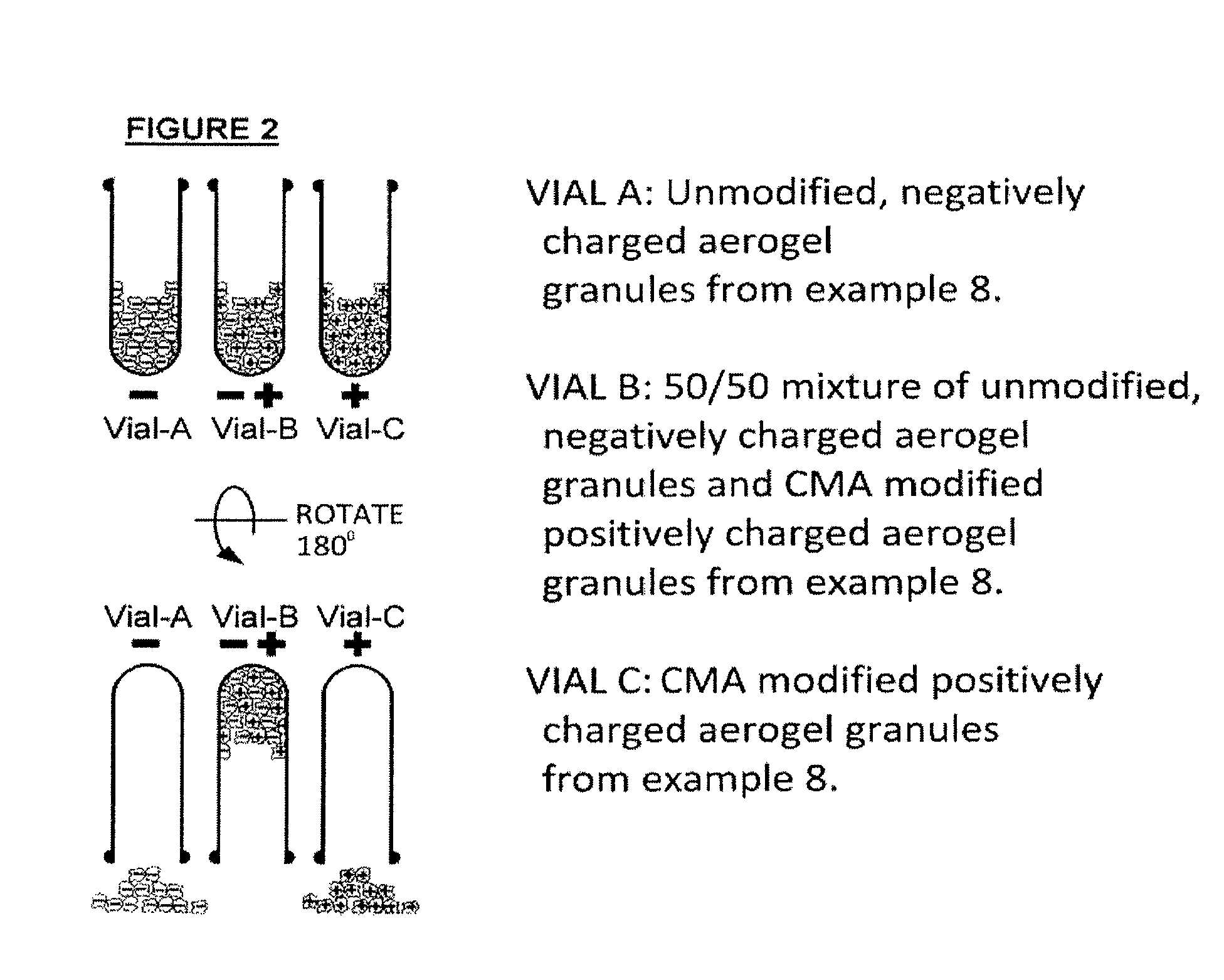Aerogel with reduced dust, static charge, and having reduced fluidity when in granular form
a technology of aerogels and fluids, applied in the direction of colloidal chemistry, other chemical processes, separation processes, etc., can solve the problems of reducing the fluidity or flowability of aerogel granules, and achieve the effect of reducing dust and aerogel loss
- Summary
- Abstract
- Description
- Claims
- Application Information
AI Technical Summary
Benefits of technology
Problems solved by technology
Method used
Image
Examples
example 1
A. Preparation of Precursor Solution
[0057]Mass of alkoxide solution (Silbond H-5)=100 grams in which the alkoxide solution is composed of:
[0058]Mass of hydrated silicate=27 grams
[0059]Mass of ethanol=73 grams
B. Preparation of Catalyst Solution
[0060]Mass of absolute EtOH=100 grams
[0061]Mass of chilled de-ionized water=65 grams
[0062]Mass of ammonium hydroxide=1.75 grams
[0063]Mass of HMDZ hydrophobing agent=10 grams
C. Creation of the Sol-Gel
[0064]Mixing solutions A and B together until a gel is formed (in about 30 to 150 seconds), the gel was then allowed to continue reacting for about an additional 5 to 30 minutes until a firm “crumbly” gel is formed. The gel was then cut into small pieces of about 5 to 20 mm in size. A sufficient amount of additional absolute ethanol was added to cover the gel particles (about 50 ml). The solution and gel were allowed to age at 50° C. for about 1 hour.
D. Creation of the Positively Charged Sol-Gel
[0065]After aging, the solvent was drained away from th...
example 2
A. Preparation of Precursor Solution
[0069]Mass of alkoxide solution (Silbond H-5)=100 grams
[0070]Mass of hydrated silicate=27 grams
[0071]Mass ethanol=73 grams
B. Preparation of Catalyst Solution
[0072]Mix together:
[0073]Mass of absolute EtOH=100 grams
[0074]Mass of chilled de-ionized water=65 grams
[0075]Mass of ethanol amine=6 grams
[0076]Mass of HMDZ hydrophobing agent=15 grams
C. Creation of the Sol-Gel
[0077]Mixing solutions A and B together until a gel was formed (in about 60 to 120 seconds) and the gel was allowed to continue reacting for an additional 5 to 30 minutes until a firm “crumbly” gel was eventually formed. The gel was then cut into small pieces of about 5 to 20 mm in size. A sufficient amount of additional absolute ethanol (about 50 ml) was added to cover the gel particles. The solution and gel were then allowed to age at 50° C. for about 1 hour.
D. Creation of the Positively Charged Sol-Gel
[0078]After aging, the solvent was drained away from the gel and 10 grams of antista...
example 3
[0081]CMA modified aerogel prepared following the procedures described in Example 1 is mixed, at various ratios, with commercially available Cabot Nanogel granules. The results of those various mixtures are described in the table below:
[0082]
Ratio of CMAModified toDustinessCabot NaogelAntistaticafter by VolumeAppearanceStickinesscharacteristicsshaking 0:100VeryNoNoYestranslucent 20:80VeryYes with YesNotranslucentslight amount of settling to bottom of vial 40:60VeryYes with noYesNotranslucentsettling tobottom of vial 50:50VeryYes with noYesNotranslucentsettling tobottom of vial 60:40VeryYes with noYesNotranslucentsettling tobottom of vial 80:20VeryYes with YesSlight translucentslight settling amount of of granules dust on to the bottom bottomof vialof vial100:0VeryNo with allNoYestranslucentgranulesfalling to the bottom of the vial
PUM
| Property | Measurement | Unit |
|---|---|---|
| Temperature | aaaaa | aaaaa |
| Temperature | aaaaa | aaaaa |
| Time | aaaaa | aaaaa |
Abstract
Description
Claims
Application Information
 Login to View More
Login to View More - R&D
- Intellectual Property
- Life Sciences
- Materials
- Tech Scout
- Unparalleled Data Quality
- Higher Quality Content
- 60% Fewer Hallucinations
Browse by: Latest US Patents, China's latest patents, Technical Efficacy Thesaurus, Application Domain, Technology Topic, Popular Technical Reports.
© 2025 PatSnap. All rights reserved.Legal|Privacy policy|Modern Slavery Act Transparency Statement|Sitemap|About US| Contact US: help@patsnap.com


